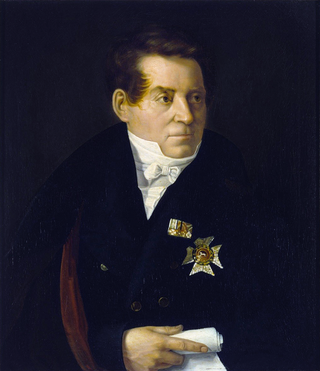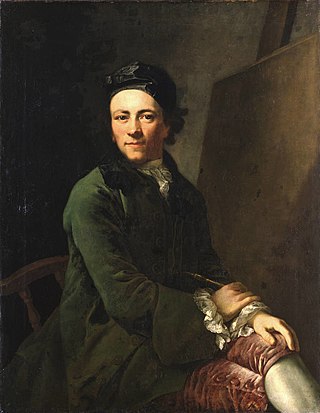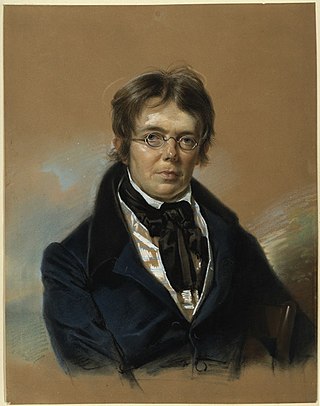
Maximilian, Margrave of Baden, also known as Max von Baden, was a German prince, general, and politician. He was heir presumptive to the throne of the Grand Duchy of Baden, and in October and November 1918 briefly served as the last chancellor of the German Empire and minister-president of Prussia. He sued for peace on Germany's behalf at the end of World War I based on U.S. President Woodrow Wilson's Fourteen Points and took steps towards transforming the government into a parliamentary system. As the German Revolution of 1918–1919 spread, he handed over the office of chancellor to SPD Chairman Friedrich Ebert and unilaterally proclaimed the abdication of Emperor Wilhelm II. Both events took place on 9 November 1918, marking the beginning of the Weimar Republic.

August WilhelmSchlegel, usually cited as August Schlegel, was a German Indologist, poet, translator and critic, and with his brother Friedrich Schlegel the leading influence within Jena Romanticism. His translations of Shakespeare turned the English dramatist's works into German classics. Schlegel was also the professor of Sanskrit in Continental Europe and produced a translation of the Bhagavad Gita.

Karl Friedrich Schinkel was a Prussian architect, city planner and painter who also designed furniture and stage sets. Schinkel was one of the most prominent architects of Germany and designed both Neoclassical and neo-Gothic buildings. His most famous buildings are found in and around Berlin.

Wilhelm Martin Philipp Christian Ludwig Liebknecht was a German socialist and one of the principal founders of the Social Democratic Party of Germany (SPD). His political career was a pioneering project combining Marxist revolutionary theory with practical legal political activity. Under his leadership, the SPD grew from a tiny sect to become Germany's largest political party. He was the father of Karl Liebknecht and Theodor Liebknecht.

Bernhard Heinrich Karl Martin, Prince of Bülow was a German statesman who served as the chancellor of the German Empire and minister-president of Prussia from 1900 to 1909. A fervent supporter of Weltpolitik, Bülow devoted his chancellorship to transforming Germany into a global power. Despite presiding over sustained economic growth and major technological advancement, his government's foreign policy did much to antagonize France and Great Britain, which contributed significantly to Germany's defeat in the First World War.

Anton Graff was an eminent Swiss portrait artist. Among his famous subjects were Friedrich Schiller, Christoph Willibald Gluck, Heinrich von Kleist, Frederick the Great, Friederike Sophie Seyler, Johann Gottfried Herder, Gotthold Ephraim Lessing, Moses Mendelssohn and Christian Felix Weiße. His pupils included Emma Körner, Philipp Otto Runge and Karl Ludwig Kaaz.

Georg Wilhelm von Siemens was a German telecommunications industrialist of the Siemens family.

Caspar Voght, later Caspar Reichsfreiherr von Voght, was a German merchant and social reformer from Hamburg. Together with his business partner and friend Georg Heinrich Sieveking he led one of the largest trading firms in Hamburg during the second half of the 18th Century. On numerous trade trips, he completely crossed the European continent. One of his greatest achievements was reforming the welfare system of Hamburg. From 1785 he dedicated himself to strengthening agricultural and horticultural projects and built a model agricultural community in Flottbek, close to the gates of Hamburg.

Franz Gerhard von Kügelgen was a German painter, noted for his portraits and history paintings. He was a professor at the Dresden Academy of Fine Arts and a member of both the Prussian and Russian Imperial Academies of Arts. His twin brother, Karl von Kügelgen, was also a painter of note.

Bruno Schmitz was a German architect best known for his monuments in the early 20th century. He worked closely with sculptors such as Emil Hundrieser, Nikolaus Geiger and Franz Metzner for integrated architectural and sculptural effect.

Dr Paul Güssfeldt was a German geologist, mountaineer and explorer.

Daniel Casper, also spelled Daniel Caspar, and referred to from 1670 as Daniel Casper von Lohenstein, was a Baroque Silesian playwright, lawyer, diplomat, poet, and chief representative of the Second Silesian School.

Ludwig des Coudres was a German history and portrait painter. He also served as a Professor at the Academy of Fine Arts, Karlsruhe. His son, Adolf Des Coudres, was a well-known landscape painter.

Christian Peter Wilhelm Friedrich Beuth was a Prussian statesman, involved in the Prussian reforms and the main mover in Prussia's industrial renewal.
The Berliner Hochschule für Technik (BHT) is the second largest University of Applied Sciences in Berlin, Germany. There are around 12 000 students studying at BHT in more than 70 majors and 795 employees, under which there are 291 professors and 43 guest lecturers.

A bronze statue of Christian Peter Wilhelm Beuth by August Kiss is installed at Schinkelplatz in Berlin, Germany.

The Watzmann is an 1824-1825 oil on canvas painting by Caspar David Friedrich, showing the Watzmann mountain as seen from Berchtesgaden to the north-east. It is now on display in the Alte Nationalgalerie in Berlin.

The Temple of Juno in Agrigento is an 1828-1830 oil on canvas painting of by Caspar David Friedrich. It is now in the Museum für Kunst und Kulturgeschichte in Dortmund, which bought it from a Cologne art dealer in 1951. It is said to have been previously owned by the F. A. Brockhaus publishers in Leipzig.

The Stauffacherin is a Swiss legendary figure. According to Swiss folklore, she was the wife of Werner Stauffacher, the Landammann of the Canton of Schwyz and a founding father of the Old Swiss Confederacy. She was depicted in Friedrich Schiller's 1804 play William Tell as an advisor to her husband, advocating for Swiss independence from Habsburg rule. The image of the Stauffacherin, often viewed as the feminine counterpart to Wilhelm Tell, has become a symbol for Swiss national pride, democracy, and women's suffrage.

















